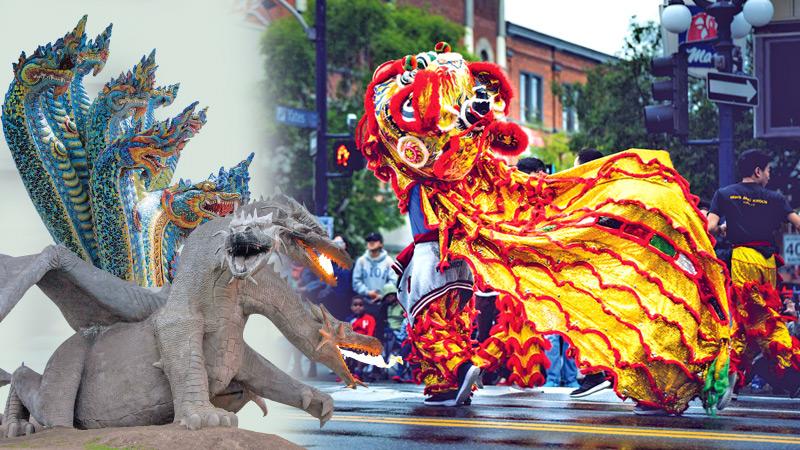
Most cultures around the world have come up with the idea of a dragon in their local folklore. Though these mythical creatures are commonly described across the board as embodying awe-inspiring power, often serving as symbols of strength, wisdom, and untamed forces of nature, the finer details have slight variations in their depictions.
 There seems to be a strong distinction between the dragons of Eastern and Western cultures, but even within those two main categories, there is a very broad range of dragon types.
There seems to be a strong distinction between the dragons of Eastern and Western cultures, but even within those two main categories, there is a very broad range of dragon types.
But how did so many different cultures, seemingly independently, come up with the idea of dragons? What is it about dragons that have had such a strong hold on traditional folklore and mythology?
The earliest known depictions of dragons can be traced back to ancient civilizations like Mesopotamia and Egypt, dating as far back as 3000 BCE, and speak generally of beasts resembling giant snakes.
A myth depicting these great serpents or dragons battling a weather/storm god or greater god appears across most ancient Eastern and Indo-European civilizations, sometimes multiple times within the same culture.
In Mesopotamian mythology, the dragon-like creature known as Tiamat represented chaos and primordial forces, who was slain by Marduk, the Storm God of the Mesopotamian pantheon.
Hotly debated
In Egyptian mythology, the serpent Apep embodied darkness and the adversary of the Sun/sky god, Ra. These early representations of dragons often portrayed them as malevolent and chaotic beings, reflecting the fears and uncertainties of the natural world.
 Though it is hotly debated, this pattern of monster snakes in myths is theorized to stem from humans’ instinctive fear of snakes. Another common theory of where the myth of dragons might come from, are from ancient discoveries of dinosaur fossils.
Though it is hotly debated, this pattern of monster snakes in myths is theorized to stem from humans’ instinctive fear of snakes. Another common theory of where the myth of dragons might come from, are from ancient discoveries of dinosaur fossils.
Chinese dragon myths, dating back thousands of years, are likely due to the high concentration of dinosaur fossils in Northern China, which is still considered by modern paleontologists to be a dinosaur hotspot.
Some depictions of dragons and other mythological creatures in Greek mythology such as the serpentine Monster of Troy match up with fossils found to be common in those regions.
However, some dragons might simply be exaggerated stories of existing exotic animal species, such as alligators or komodo dragons.
Revered creature
Dragons in later cultures, like the Chinese dragon, for instance, is a revered creature associated with prosperity and good fortune. Unlike the earlier depictions as incarnations of the world’s evils, and fire-breathing monsters in the West, Chinese dragons are benevolent beings, often depicted as wise and compassionate, protecting the land and its people.
Early depictions of the Chinese dragon were based on the Yinglong, a rain deity, and serpentine dragon that was generally depicted with wings. Later, the most common image of the Chinese dragon became that of the Huanglong, the Yellow Dragon, which has the highly recognizable long body, and wings being replaced by fire and cloud patterns.
Dance
Many Chinese customs and traditions revolve around the Chinese dragon, such as the dragon dance during Chinese New Year celebrations symbolizes the spirit of the dragon bringing luck and prosperity for the coming year.
In stark contrast, the Western dragon has become the archetypal antagonist, terrorizing towns and knights alike. Rooted in the mythology of ancient Greece, the dragon is often portrayed as a monstrous creature living in cavernous lairs, guarding hoards of treasure or kidnapping princesses.
Earlier depictions of the European dragon were longer and serpentine like the ancient civilizations before. They generally took an adversarial role in medieval stories, and were often associated with Satan.
The legend of Saint George and the Dragon is one of the most famous tales where a heroic knight slays a fearsome dragon to save a princess and liberate a kingdom from its tyranny.
In recent times, dragons have become entrenched in popular culture, with numerous books, movies, and television shows featuring these mythical creatures, depicting them as intelligent, majestic and magical creatures.
Early popular portrayals that have fed into this idea include Lewis Carroll’s Jabberwocky, and Smaug from JRR Tolkien’s ‘The Hobbit’.
More modern depictions of dragons from George R.R. Martin’s ‘Game of Thrones’, and Christopher Paolini’s ‘Inheritance Cycle’ have continued to captivate audiences worldwide, adapting and evolving their mythology in contemporary narratives.
